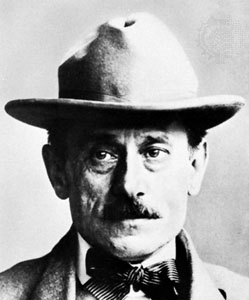Tony Garnier (architect) facts for kids
Quick facts for kids
Tony Garnier
|
|
|---|---|

Portrait of Tony Garnier
|
|
| Born | 13 August 1869 Lyon, France
|
| Died | 19 January 1948 (aged 78) Roquefort-la-Bédoule, France
|
| Nationality | French |
| Alma mater | École nationale des beaux-arts de Lyon École nationale supérieure des Beaux-Arts |
| Occupation | Architect |
| Awards | Prix de Rome |
| Buildings | Halle Tony Garnier, Stade de Gerland |
| Projects | Cité Industrielle |
Tony Garnier (born August 13, 1869 – died January 19, 1948) was a famous French architect and city planner. He worked mostly in his hometown of Lyon, France. There, he designed important buildings like the Halle Tony Garnier and the Stade de Gerland. Many people see Garnier as one of the most important French architects of the 20th century.
Contents
Tony Garnier's Life Story
Early Life and Education
Tony Garnier started his journey by learning painting and drawing. He studied at the École Technique de la Martinière in Lyon from 1883 to 1886. After that, he focused on architecture. He attended the École nationale des beaux-arts de Lyon from 1886 to 1889. Later, he moved to Paris to study at the famous École nationale supérieure des Beaux-Arts from 1890 to 1899.
Winning the Prix de Rome
In 1899, Tony Garnier won a very special award called the Prix de Rome. He earned it for his design of a national bank. This prize allowed him to live and study in Rome, Italy, for four years. He stayed at the beautiful Villa Medici until 1904. During his time in Rome, he started working on a big idea. This idea was a plan for an industrial city, which became his most important work in city planning.
Designing the Ideal City
In 1901, Tony Garnier began to develop his ideas for city design. He thought a lot about how people live and how cities work. His main idea was to separate different parts of a city by their purpose. This is called zoning. He planned areas for factories, public buildings, homes, hospitals, and places for fun.
His detailed drawings for this ideal industrial city were called Une Cité Industrielle. He first showed these plans in 1904. However, they were not fully published until 1918.
What was Une Cité Industrielle?
Une Cité Industrielle was a dream city designed for 35,000 people. It was meant to be a perfect place to live, a kind of utopia. Garnier placed it between a mountain and a river. This location would make it easy to get clean energy from water.
His ideas were inspired by the writer Émile Zola, especially Zola's book Travail. In Garnier's city plan, schools and job training centers were close to the industries they served. This made it easier for people to learn skills for work. The city had no churches or police stations. Garnier hoped people could live peacefully and govern themselves. The idea of separating city areas by their use was later adopted by other architects. It even influenced the design of cities like Brasilia.
Returning to Lyon and Major Projects
In 1904, Tony Garnier moved back to Lyon. He quickly received a big job: designing a livestock market and a slaughterhouse. This project, built from 1906 to 1924, is now known as the Halle Tony Garnier. Today, it's a popular place for concerts and events.
In 1910, he was asked to design the Édouard-Hérriot Hospital, which was finished in 1927. Other projects included several homes, the Stade de Gerland (a large sports stadium) built from 1914 to 1918, and affordable housing. This housing project was called Quartier des Etats-Unis (United States Quarter) and was built from 1919 to 1935.
Later Life
Tony Garnier continued working on many important projects in the 1920s. In 1939, he left Lyon and moved to Roquefort-la-Bédoule. He passed away there in 1948. He is buried in the Croix-Rousse cemetery in Lyon.
Key Projects by Tony Garnier
- Cité Industrielle, his famous plan for an ideal city, 1904.
- Slaughterhouse and Stockyard, later named Halle Tony Garnier, Lyon, 1905-1924. This building is now a music venue.
- Vacherie du Parc, Lyon, 1904-1905.
- Grange-Blanche Hospital (now H. Edouard Herriot Hospital), Lyon, 1910-1927.
- Villa Tony Garnier, Saint-Rambert, Lyon, 1911.
- Stade de Gerland municipal stadium, Lyon, 1914-1918.
- Quartier des Etats-Unis housing, Lyon, 1919-1935.
- Villa Gros, Saint-Didier, 1921.
- Sanatorium, Saint-Hilaire de Touvet, 1923.
- Lyon and Saint-Etienne Pavilions at the International Exposition of Modern Industrial and Decorative Arts, Paris, 1925.
- Hotel de Ville (town hall), Boulogne-Billancourt (with Jacques Debat-Ponsan), 1934.
Images for kids
Related Articles
- War memorial on Île du Souvenir


